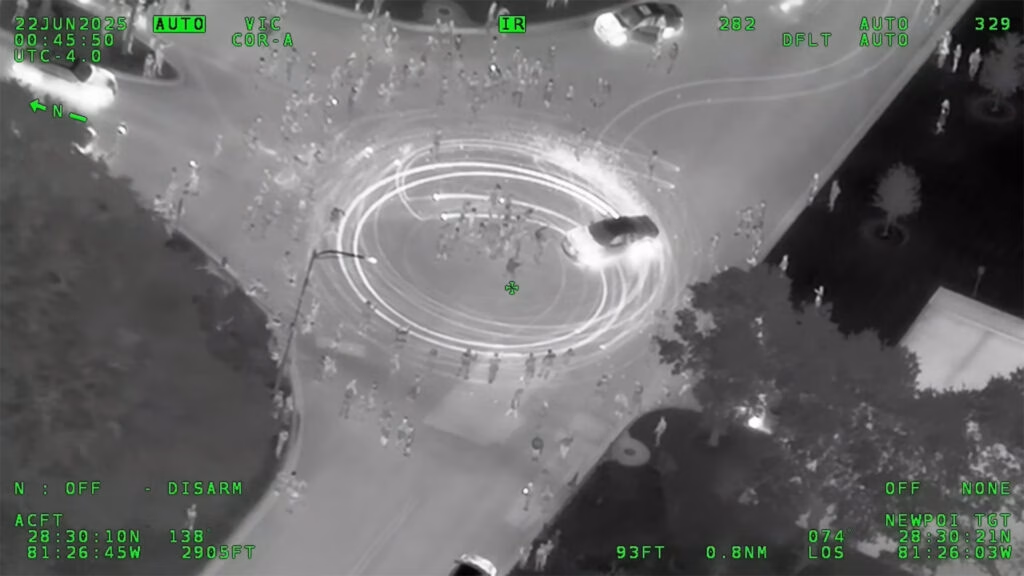How Did Florida Police Use a Helicopter to Catch a Street Takeover Suspect?
When a street takeover erupted in Orange County, Florida, the Florida Highway Patrol (FHP) didn’t just send in squad cars. Instead, they took a page from modern policing and deployed a helicopter to quietly monitor the chaos from above. The result? Pure magic. The eye in the sky tracked a white Dodge Charger as it performed burnouts, then followed it as the driver tried to slip away into the night.
Instead of a risky, high-speed chase, officers coordinated on the ground. Five patrol cars calmly boxed in the suspect at a stoplight, making the arrest without drama or danger. Both the driver and passenger now face charges for their role in the illegal event. It’s a textbook example of how technology and patience can outsmart even the boldest offenders.
Why Are Street Takeovers So Hard to Police?
Street takeovers—where dozens of cars block intersections for stunts—aren’t just a Florida problem. Cities from Los Angeles to Chicago have struggled with these pop-up events. The challenge? Sheer numbers and unpredictability. In this Florida incident, over 20 vehicles and a crowd of spectators swarmed the intersection at 12:44 a.m. By the time police arrive, most participants scatter.
Traditional policing methods often fall short. Chasing multiple suspects through city streets can endanger bystanders and officers alike. That’s why more departments are turning to aerial surveillance, automated license plate readers, and even social media monitoring to get ahead of these gatherings. But as this case shows, even with a helicopter and five patrol cars, nabbing just one participant is a resource-heavy operation.
What Does This Arrest Reveal About Law Enforcement Tactics?
This operation highlights a shift in how police approach street takeovers. Instead of brute force or high-speed pursuits, agencies are opting for surgical precision. The FHP’s use of a helicopter allowed them to document the scene, identify key players, and coordinate a safe, controlled arrest. No one was hurt. No cars crashed. The suspect didn’t even realize they were being tailed until it was too late.
But here’s the kicker: the resources required are immense. One helicopter, multiple patrol cars, and a coordinated team—all to arrest a single driver. According to a 2023 report from the National Highway Traffic Safety Administration, street racing and takeovers have surged post-pandemic, stretching police resources thin in many cities. Departments are forced to prioritize which incidents to pursue, often letting many participants slip away.
Are These High-Tech Tactics Making a Difference?
There’s no denying that technology is changing the game. Helicopters, drones, and surveillance cameras are helping police gather evidence and make safer arrests. In Los Angeles, for example, the use of aerial units has led to a 30% increase in arrests related to street racing and takeovers since 2022, according to LAPD data. Florida’s recent operation fits this trend—smart, patient, and less risky for everyone involved.
However, critics argue that these tactics are a drop in the bucket. For every driver arrested, dozens more get away. And the spectacle of street takeovers—often broadcast live on social media—continues to attract new participants. Some cities are experimenting with harsher penalties, vehicle impoundments, and even civil lawsuits against organizers. But the cat-and-mouse game is far from over.
What Can Communities and Law Enforcement Do Next?
If you’re wondering what comes next, you’re not alone. Law enforcement can’t be everywhere at once, and the resource drain is real. Community engagement is key—educating young drivers about the risks, working with local businesses to secure vulnerable intersections, and encouraging residents to report suspicious activity. Some cities have even created legal venues for car enthusiasts to show off their skills safely, reducing the allure of illegal takeovers.
The big takeaway? Tackling street takeovers isn’t about perfection—it’s about smarter adjustments. Start with one change this week, and you’ll likely spot the difference by month’s end. Whether it’s better tech, stronger community ties, or just a bit more patience, every step counts in making our streets safer.

